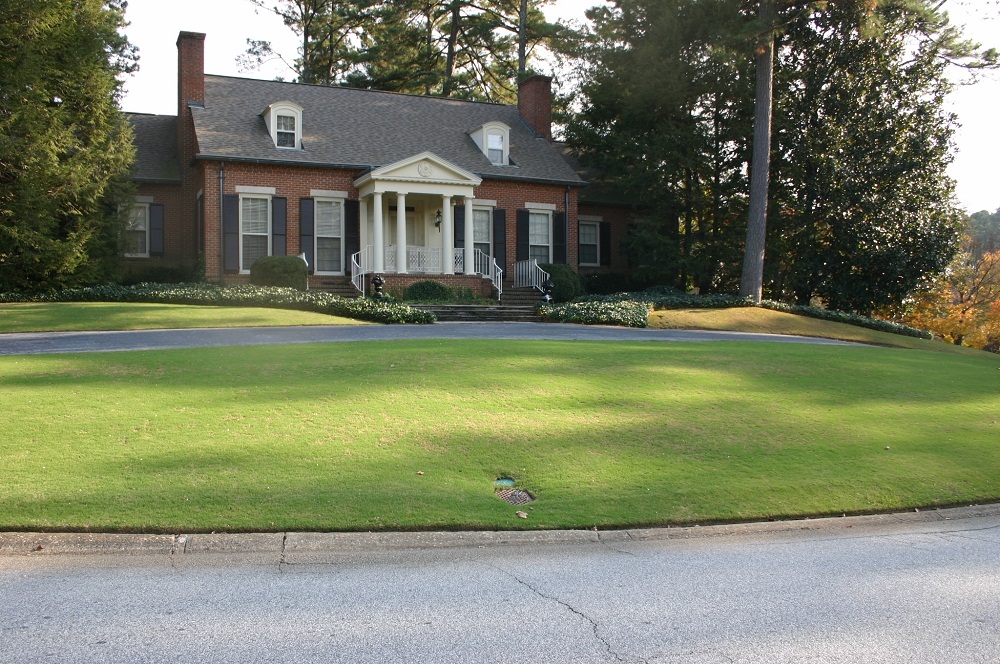Lawn – Growing in Shade

OK. I admit it. I have given up. I came to the conclusion that grass just would not grow in the corner of my lawn near the ornamental cherry trees. The shade there is so dense that my grass, no matter how lush in April, thinned out to bare soil for five years running. This spring I planted hydrangea, white impatiens, golden hosta and variegated ivy there and the spot looks better than it ever has.
Trees and shade look nice in the landscape. However, it is difficult to grow grass under trees because not only the quantity but also the quality of the light changes in the shade. In full sun, light is in the “near red” range of wavelengths. In the shade it shifts to the “far red,” which is less effective for photosynthesis. The result is a reduction in the food needed for turf growth. Leaves and stems of grass plants are thinner in shade. Moisture from dew under trees takes longer to evaporate. The additional moisture may contribute to an increase in disease.
With the deck stacked against it, it is remarkable that any grass grows under trees. If you let experience, rather than me, be your teacher, these tips will help you grow grass in the shade. Go to How Much Light Does a Lawn Need before you read further.
CHOOSE RIGHT GRASS Under high pine tree shade, bermudagrass and zoysiagrass can grow successfully. Beneath the shade of a dogwood or an oak, both fail miserably. Use turfgrasses adapted to your area of Georgia. Fine and tall fescue are adapted to north Georgia. Dependent on the variety; zoysiagrass, centipedegrass, and bermudagrass can be grown throughout the state.
Cool season grasses –Fescue is the most shade-tolerant grass that is adapted to the Atlanta area but there is little difference between the various named fescue seed brands. Fine fescues may survive in some situations. When establishing cool-season grasses, it is best to seed or sod early enough in the fall so there is sufficient time for the turfgrass to mature before leaves cover the ground. During the fall remove leaves by raking, blowing or bagging when mowing to prevent smothering of the grass. Cool-season turfgrasses will grow long after deciduous trees have dropped their leaves.
Warm season grasses – In general bermudagrass is intolerant to shade. Two newer cultivars, TifGrand and Celebration have shown good persistence under shade conditions. These cultivars may be options in environments where the grass receives 6 hours or better of filtered to intermittent shade. Likewise, centipedegrass needs the same light conditions as these two bermudagrass cultivars.
Some St. Augustinegrass cultivars have suitable tolerance to shade. Examples include Palmetto, Mercedes, and Raleigh.
Similarly, some zoysiagrass cultivars are tolerant to limited light environments. Zoysiagrass cultivars that have good tolerance to shade include El Toro, JaMur, Zeon, and Zorro. These species have performed well under a heavy hardwood shade for 5 years. Cavalier has also been reported to have good shade tolerance while the older cultivar, Meyer, has fair tolerance.
PRUNE TREES Selective pruning and thinning of limbs within the tree canopy will allow better sunlight penetration. Single tall trees should have all limbs removed below 10 feet. Rake and remove leaves or needles before they accumulate.
MOW HIGHER Grass in the shade should be cut approximately 1/2 to 1 inch higher than the grass growing in full sunlight. This will allow more leaf area to intercept the limited amount of sunlight. Avoid scalping turf in the spring. Decline of turf in shade often begins after a single episode of scalping.
WATER MORE Tree roots compete with the turfgrass for available soil moisture. In addition, the distribution of moisture from rainfall is poor under a tree canopy. The tree leaves block or deflect the rainfall. This yields an uneven soil moisture pattern. As a rule of thumb, turfgrass in shade needs 1 inch or more of water per week. In the absence of rainfall, wet the soil to a 6-inch depth. This may take 2 to 3 hours for one irrigation application.
MINIMIZE TRAFFIC During the summer months, minimize the traffic and activities in the shaded grass areas. This will reduce the wear stress on the turf. If the grass is in a path where traffic can not be avoided, place stepping stones or pine bark to mark the trail.
LIMIT FERTILIZER Grass grown in the shade should receive half the fertilizer than that in the sun. Follow the fertilizer schedule at my Lawn Care Calendars page
LIMIT WEEDKILLERS Use broadleaf weed controls sparingly on shaded lawns. Spot-spray special weeds like wild violet. Crabgrass controls are not necessary in a shade environment since crabgrass needs a high light intensity to germinate.
USE GROUNDCOVER OR MULCH In areas where even fescue fails, think about using light-colored groundcovers like I did. A layer of pinestraw or pine chips looks much better than bare dirt. As one of my gardener buddies says, “Nature always bats last!”
see also Using Mondo Grass for a Lawn

shady lawn












